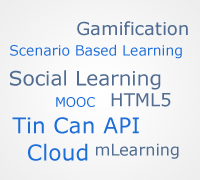
eLearning has come a long way from first being an instructor led power-point teaching to self-paced courses on device of user’s choice. Technology has changed the way we work, the way we shop, the way we socialize and increasingly changing the way we learn too.
eLearning market has been predicted to grow globally from $90bn in 2012 to $166.5bn in 2015 and $255bn in 2017,that is a Compound Annual Growth Rate (CAGR) of 23% between 2012-17. Experts predict that eLearning is going to be more mobile in coming years, which will open it up to a broad audience especially in South Asia where many people have access to the internet via their cell phones alone.
At the half mark through 2013, here are the key eLearning industry trends that I consider the best coming our way:
1- Gamification
With all the hype surrounding the term “Gamification in eLearning”, it is easy to get lost in the myriads of information and interpretations out there. In simple terms, Gamification is imparting the principles of game thinking and game mechanics to engage users in solving the problems.
Games create engagement—the keystone of a positive learning experience, keeping this in mind and the growing number of millennial learners, it is vital that gamification be part of every learning professional’s tool box.
2- Scenario Based Learning- Maximizing returns in eLearning
Scenario based learning provides exposure to a learner on a given situation (which can range from ‘n’ number of business scenarios, problems etc.) and requires them to apply knowledge relevant to that situation. Scenario based learning helps in reinforce learning, measuring success or failure of the learner according to the scenario’s result and hence identify the gaps in learning.
With increasing demand of organizations to maximize their returns in eLearning, an effective and accurate way to identify the success of training and learning content, is the need of the hour.
3- Massive Open Online Courses – More universities to join the wagon
Massive open online courses (MOOC) are similar to online college courses but are open to anyone who wants to take the course. Many elite universities like Stanford, MIT, and Carnegie Mellon etc. upon seeing the success of this format have begun to offer online version of their courses to the public either free or paid. Many organizations too are turning to on-demand MOOC style courses and programs rather than hosting weekend courses or traditional in-house short courses.
4- HTML5 as an alternative to Flash
HTML 5 offers many enhanced functionalities and capabilities than Flash. With high significance of interactive media usage in eLearning, HTML5’s ability to support embedded multimedia without an external plug-in is hard to understate.
Also with the growing number of smart-phone and tablet users, HTML5 adds more value with its high accessibility and is compatible with a wide variety of browsers and devices.
5- Tin Can API- Increased adoption
Tin Can API can track and recognize wide range of learning activities, including non web-based content. It provides course creators the freedom to use various types and forms of content in online or offline mode. Tin Can API also allows saving of every experience/activity on Learning Record Store.
Its support for native apps on mobile devices and the ability to track experiences and activities effectively will further add weight to its adoption rate among organizations.
6- Social Learning
In this digital age, millennial learner’s want collaborative and anytime, anywhere, any device access to the learning content. Content co-creation and sharing creates an augmented layer of rich content to the actual content. This makes the learning more effective and engaging for the user.
In the coming days we will see more collaborative and social flavour being incorporated in eLearning solutions, for example annotation engine, real time collaborative editor etc.
7- mLearning- Educational Apps and Emergence of RWD
As pointed out in the above trend about digital age, more and more learners are turning to their tablets and smart-phones for searching, accessing and sharing of information. eLearning designers are recognizing this and putting considerable effort and discussion in mobile, which is shown by the growing number of educational apps being developed. Also responsive web design (RWD) is gaining interest among content creators. RWD can adapt to the various different screen sizes and devices irrespective of underlying operating system in use.
And with the growing number of mobile devices being shipped, Mobile First would definitely be the new mantra.
8- Performance support adoption to grow rapidly
Organizations have realized that traditional methods of corporate eLearning would simply not work as employees forget most of the training imparted within a month. Organizations need to provide practical oriented insightful information to the employee when he need sit, to accomplish the task. Performance support systems if implemented correctly provide highly pertinent, bite-sized information in the hands of employee seamlessly. Performance support systems will be the bridge to link training to putting a sizeable impact on business and eventually financial benefits.
9- Cloud
As pointed out earlier that, learners want anytime, anywhere and any device access to the training content. Utilizing Cloud based solutions to store your information- from learning tools to courses will enable and empower learners to take and share courses and content with other learners from anywhere.
It will be interesting to see how changes in technologies and adoption of new standards will affect the eLearning industry especially in terms of providing better learning engagement for the user and to track it effectively for an accurate ROI for the organization.






